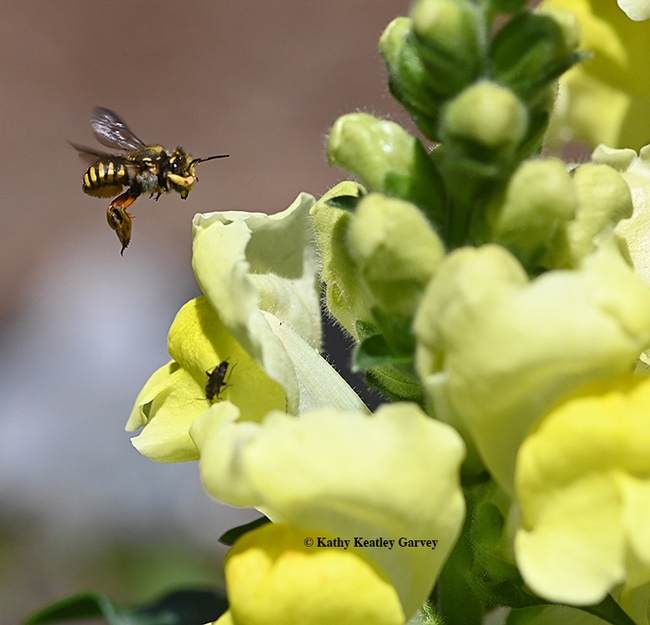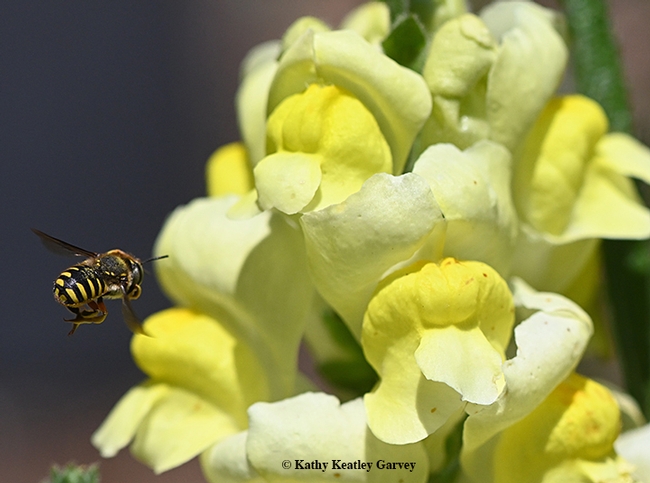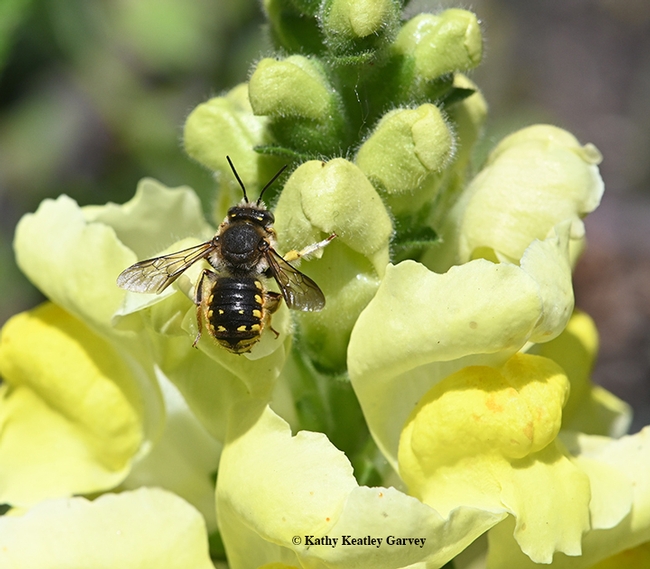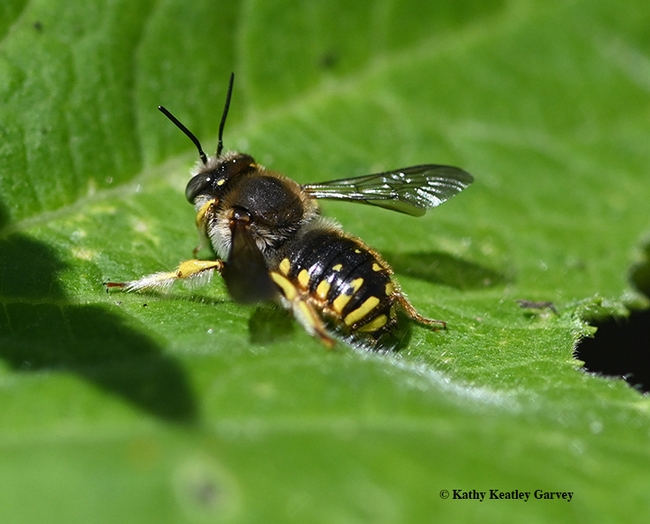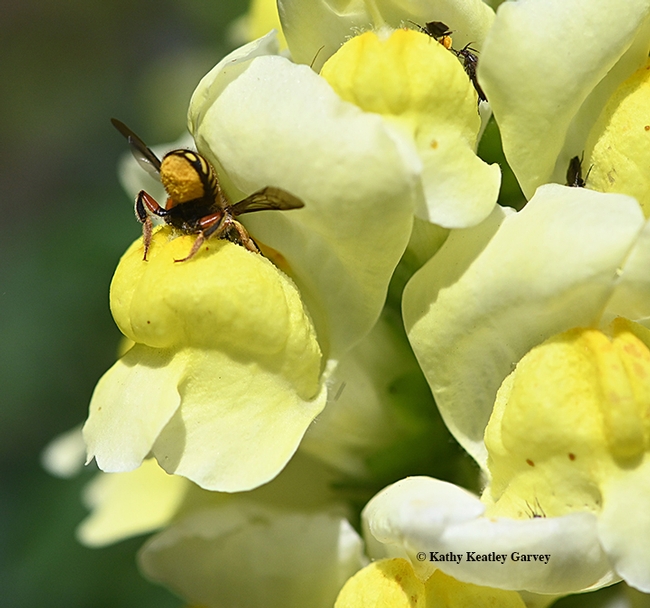- Author: Kathy Keatley Garvey
It's almost the end of the season for the European wool carder bee, Anthidium manicatum.
A few still hang around the foxgloves, the catmint and the African blue basil in our pollinator garden. They really stand out when they're visiting the hot pink foxgloves (by the way, all parts are poisonous except for the roots), but they're difficult to see when they line up with the African blue basil and the catmint.
Natives of Europe, they were named "carder bees" because the females collect or "card" plant hairs for their nests. The bees, about the size of honey bees, are mostly black and yellow. The females range in body length from 11 to 13 millimeters, while the males are 14 to 17 mm. The males are very territorial as they protect their turf and bodyslam other insects.
These colorful bees were first detected in the United States (New York) in 1963, and first recorded in California (Sunnyvale) in 2007. By 2008, they were well established in the Central Valley, according to Lynn Kimsey, director of the Bohart Museum of Entomology and a UC Davis distinguished professor of entomology. We saw our first one in Vacaville in the spring of 2010.
The bee, according to research entomologist Tom Zavortink of the Bohart Museum of Entomology at UC Davis, was accidentally introduced into New York state. It was not purposefully introduced to pollinate alfalfa, as some reports allege, he said.
Writing in a 2008 edition of the Pan-Pacific Entomologist, Zavortink and fellow entomologist Sandra Shanks, now of Port Townsend, Wash., pointed out that several papers “have documented its spread from neighboring areas in the northeastern United States and southern Canada” and that the species has since crossed the country. It was confirmed in Colorado in 2005, Missouri in 2006, and Maine, Michigan, Maryland and California (Sunnyvale) in 2007, the entomologists wrote. Records show it was first collected in Davis on July 26, 2007.
Its plant preferences include lamb's ear (Stachys byzantine, in the mint family Lamiaceae), a perennial grown for its fuzzy, silvery gray-green foliage. It's also been collected in the figwort/snapdragon family (Scrophulariacae) and the pea and bean family (Fabaceae), according to the Zavortink-Shanks research.
In our yard, they're partial to the foxgloves (shaded) and catmint (full sun). They don't seem to like the lamb's ear (full sun).
They also don't like my camera. The slightest movement, and off they go.
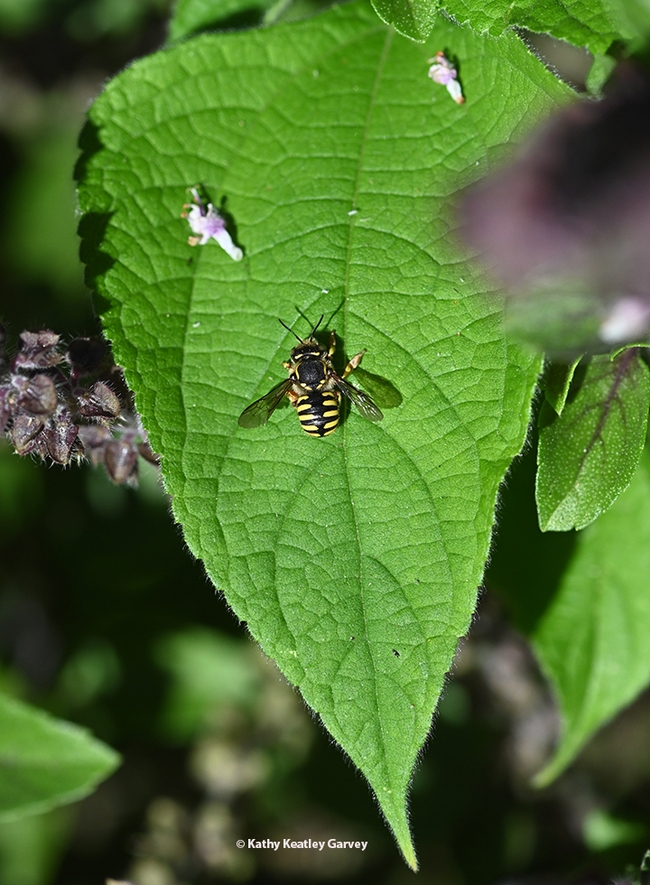
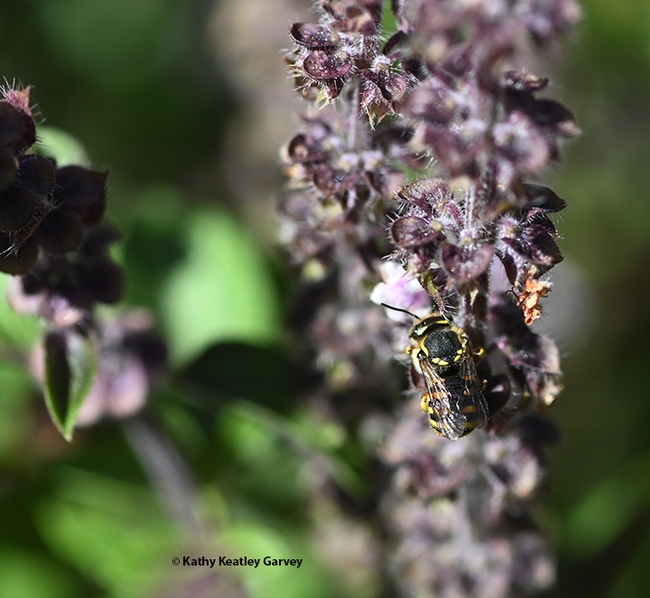
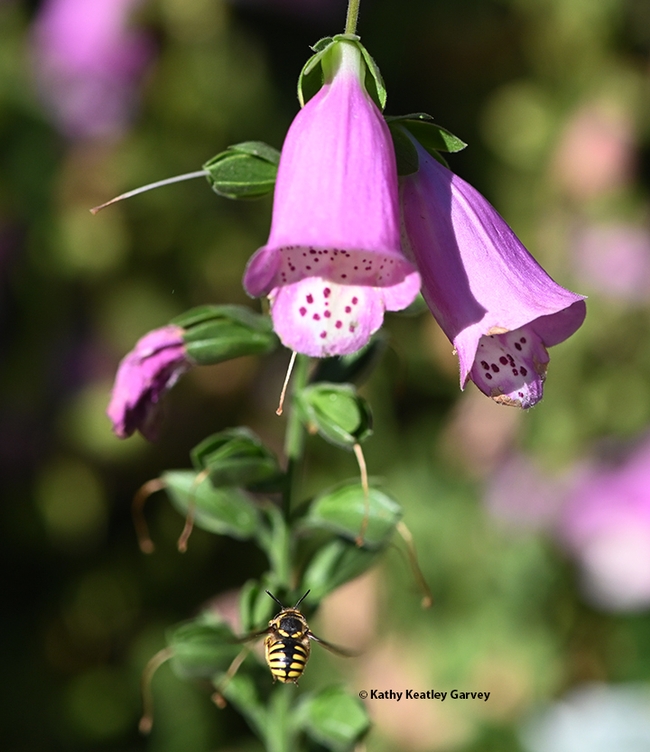
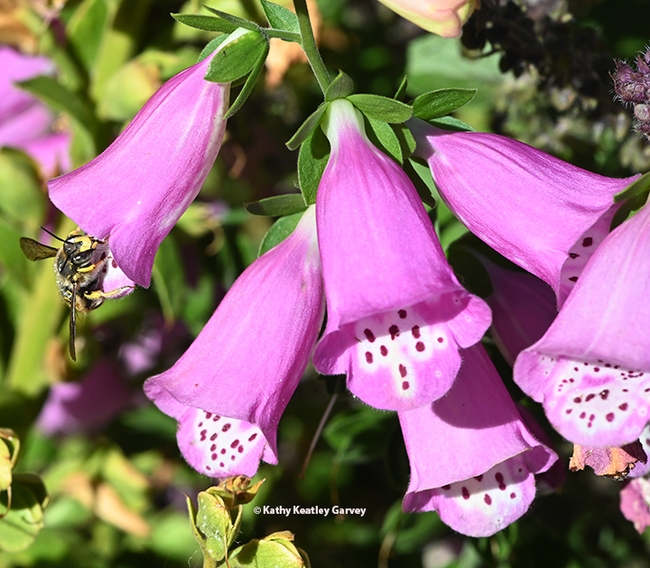
- Author: Kathy Keatley Garvey
Seen any European wool carder bees lately?
European wool carder bees (so named because the female collects or cards plant hairs for their nests) are on the move.
The bees, about the size of honey bees, are mostly black and yellow. The females range in body length from 11 to 13 millimeters, while the males are 14 to 17 mm.
The males are known for being very territorial. They body-slam other insects to protect their turf, per chance to mate with the females.
The European wool carder bees, Anthidium manicatum, are natives of Europe. Their "immigrant ancestor" was first detected in the United States (New York) in 1963, and the species then began spreading west. The bees were first recorded in California (Sunnyvale) in 2007.
The species, according to research entomologist Tom Zavortink of the Bohart Museum of Entomology at UC Davis, was accidentally introduced into New York state. They were not purposefully introduced to pollinate alfalfa, as some reports allege, he said.
Writing in a 2008 edition of the Pan-Pacific Entomologist, Zavortink and fellow entomologist Sandra Shanks, now of Port Townsend, Wash., pointed out that several papers “have documented its spread from neighboring areas in the northeastern United States and southern Canada” and that the species has since crossed the country. It was confirmed in Colorado in 2005, Missouri in 2006, and Maine, Michigan, Maryland and California (Sunnyvale) in 2007, the entomologists wrote. Records show it was first collected in Davis on July 26, 2007.
It was well established in the Central Valley by 2008, according to Lynn Kimsey, director of the Bohart Museum of Entomology and a UC Davis distinguished professor of entomology.
We first encountered the European wool carder bee in Vacaville, Solano County, in the spring of 2010. Its plant preferences include lamb's ear (Stachys byzantine, in the mint family Lamiaceae), a perennial grown for its fuzzy, silvery gray-green foliage. It's also been collected in the figwort/snapdragon family (Scrophulariacae) and the pea and bean family (Fabaceae), according to the Zavortink-Shanks research.
In our pollinator garden, they seem to prefer foxgloves, lamb's ear, catmint and lavender. Yes, in that order...
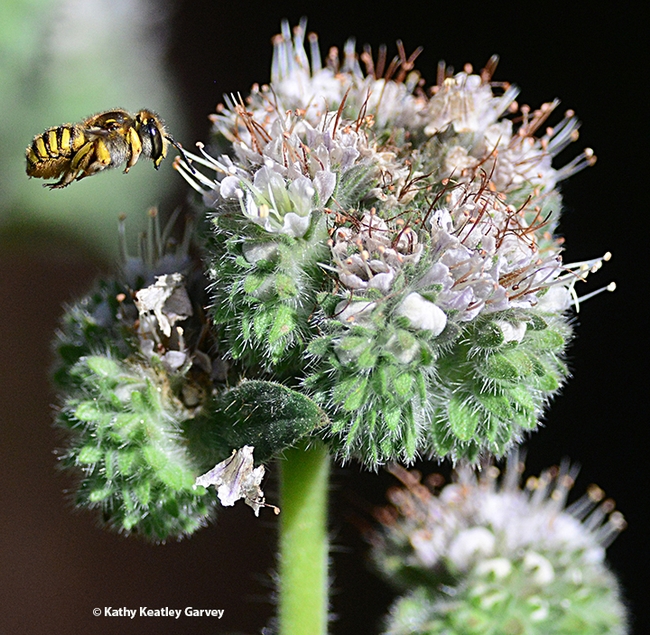
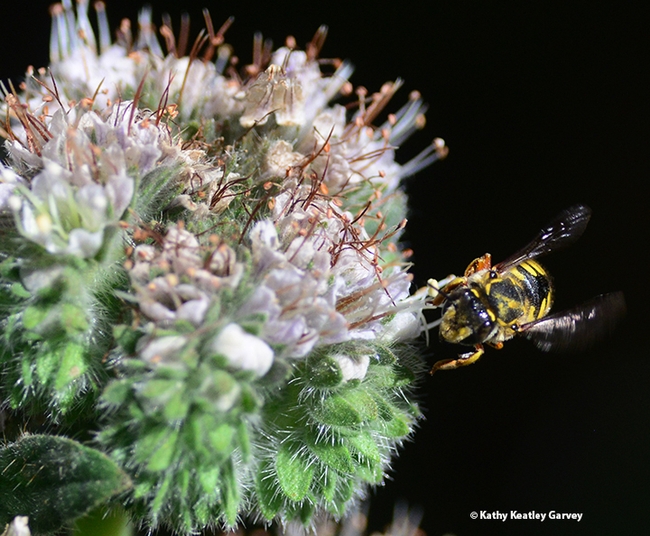
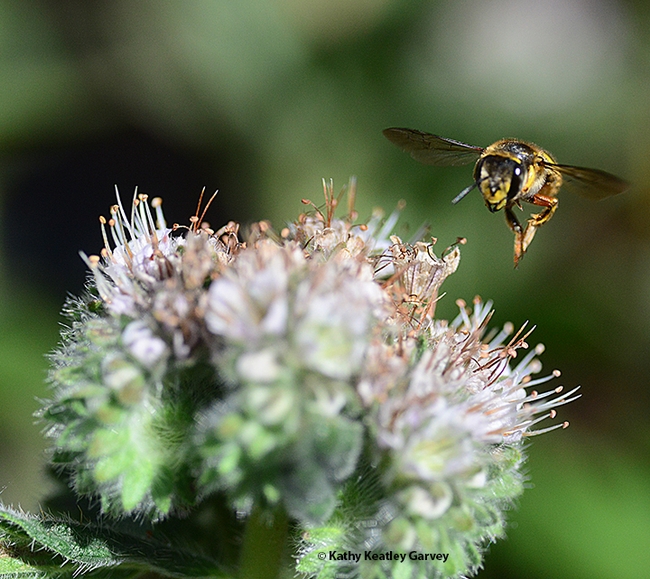
- Author: Kathy Keatley Garvey
Learning more about insects ought to be one of your New Year's resolutions.
Here's a good place to start: read the UC Davis Bohart Museum of Entomology's Insect Information Sheets.
Terry Erwin of the Smithsonian Institution's Department of Entomology estimates the number of living species of insects at 30 million. "Insects also probably have the largest biomass of the terrestrial animals," according to the Smithsonian website. "At any time, it is estimated that there are some 10 quintillion (10,000,000,000,000,000,000) individual insects alive."
Some other points from the Smithsonian scientists:
- "In the United States, the number of described species is approximately 91,000. The undescribed species of insects in the United States, however, is estimated at some 73,000. The largest numbers of described species in the U.S. fall into four insect Orders: Coleoptera (beetles) at 23,700, Diptera (flies) at 19,600, Hymenoptera (ants, bees, wasps) at 17,500, and Lepidoptera (moths and butterflies) at 11,500."
- "Certain social insects have large numbers in their nests. An ant nest in Jamaica was calculated to include 630,000 individuals. A South American termite nest was found to have 3 million individuals. Locust swarms are said to hold up to one billion individuals."
- "Insects have remarkable fertility and reproductive abilities, which have usually led to the vast numbers of individuals in nature. East African termite queens have been recorded to lay an egg every two seconds, amounting to 43,000 eggs each day. To appreciate the population potentials of insects the example of the housefly is sometimes used, stating that the descendants of one pair of this insect, provided that they all survived during a five month season, would total 190 quintillion individuals."
-
"Recent figures indicate that there are more than 200 million insects for each human on the planet! A recent article in The New York Times claimed that the world holds 300 pounds of insects for every pound of human."
So, if you weighed all the bugs of the world, they would weigh much more than all the people in the world. (See fivethirtyeight.com)
The Bohart Museum information sheets will inform you about ants, beetles, wasps, bees, mites, ticks, flies, butterflies, moths, true bugs, praying mantids, Jerusalem crickets (aka potato bugs), earwigs, booklice, and additional home pests (no, not the permanent occupants of your home).
The fact sheets also cover such non-insects as spiders (arachnids), house centipedes, springtails, sowbugs, scorpions, lawn shrimp, and earthworms and the like (if you don't like them, you can at least appreciate them).
One of the bees featured is the European wool carder bee, Anthidium manicatum. It's a "species of European megachilid bee that has successfully colonized North America," Kimsey writes. "However, North America isn't the only place these bees have invaded. They are now found in north Africa, South America, Asia the Canary Islands and even New Zealand."
The bee, introduced into the United States from Europe in the early 1960s, was first detected in New York state "but has rapidly spread throughout North America since then," Kimsey points out. "The first California collection was in the early 2000's and the bee had reached Davis by 2007."
"Wool carder females are particularly fond of lamb's ears (Stachys byzantina) and as a result this is often where males are found. Females use their jaws to scrape, or card the hairy leaves to collect fibers. They can be pretty entertaining if they decide that wool socks are good sources of fibers, too" (as what happened to Bohart associate Tom Zavortink.)
Male wool carder bees are aggressively territorial. They'll attack other bees, including honey bees and carpenter bees, "and even small birds, like hummingbirds," Kimsey says.
Photographer Allan Jones of Davis calls the male wool carder bees "bonker bees," because they bonk or bop off would-be competitors from floral resources--or they try to.
The wonderful world of insects...
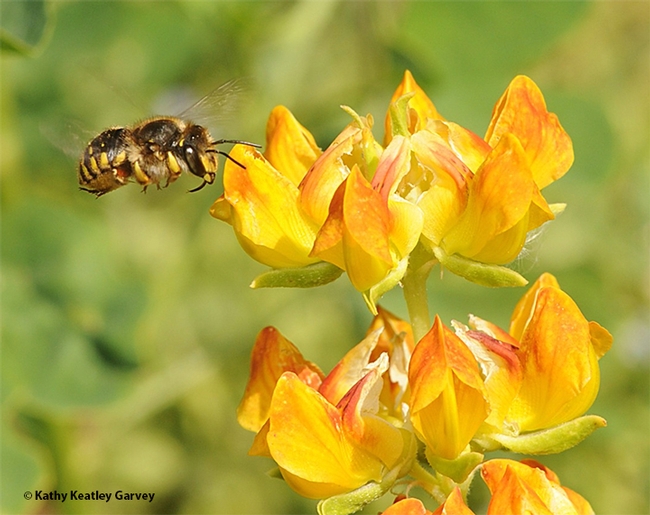
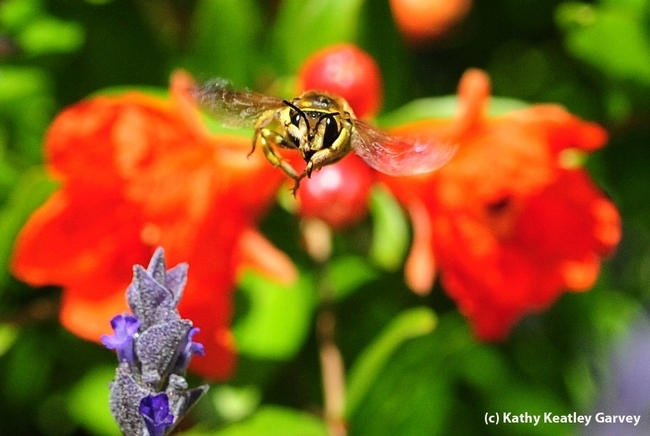
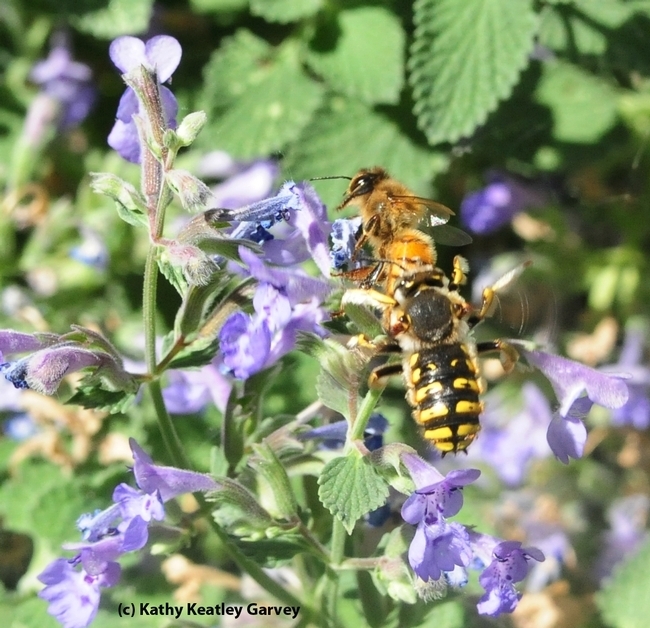
- Author: Kathy Keatley Garvey
Love is in the air.
Or, more specifically, in the snapdragons.
If you maintain a pollinator garden, you've probably seen female European wool carder bees (Anthidium manicatum) nectaring on flowers or scraping or carding fuzz for their nests. You've probably seen the males being thoroughly territorial, protecting their turf, bodyslamming other insects off blossoms, and chasing the girls.
Last weekend, however, we encountered--and photographed--a different kind of behavior.
Reproductive behavior.
A male on a mission.
And a time to engage in a little insect wedding photography. (See images below)
About Size of Honey Bees
The European wool carder bees, about the size of honey bees, are fascinating to watch--and they're striking in color as well. Their yellow faces and yellow markings on their black abdomens readily distinguish them.
Males are considerably larger than females, and have a spine on either side of the last two abdominal segments and three spines on the last segment, according to Lynn Kimsey, director of the Bohart Museum of Entomology and professor of entomology at UC Davis. Those spines have been mistaken for stingers, but only females have stingers.
Research entomologist Tom Zavortink of the Bohart Museum and colleague Sandy Shanks wrote about the bee in the 2008 edition of the Pan-Pacific Entomologist. The bee belongs to the family Megachilidae (which also includes leafcutter and mason bees, among others). First introduced into the United States (New York) from Europe in 1963, it quickly spread across the continent. It was confirmed in Colorado in 2005, Missouri in 2006, and Maine, Michigan, Maryland and California (Sunnyvale) in 2007, the entomologists wrote. They found the species in Davis in 2007.
Kimsey says the carder bee was well established in the Central Valley by 2008. We spotted it in Vacaville in the spring of 2010 and now try to plant three of its preferences: the fuzzy lamb's ear (Stachys byzantine in the mint family Lamiaceae), snapdragons (Scrophulariacae); and foxgloves (Plantaginaceae).
The welcome mat is out. So is the red carpet.
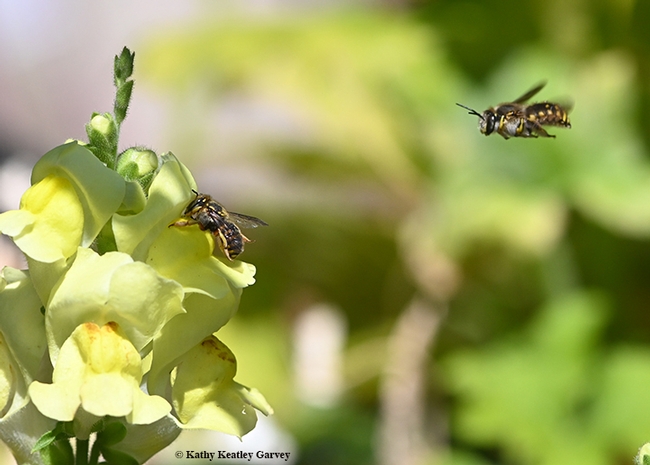
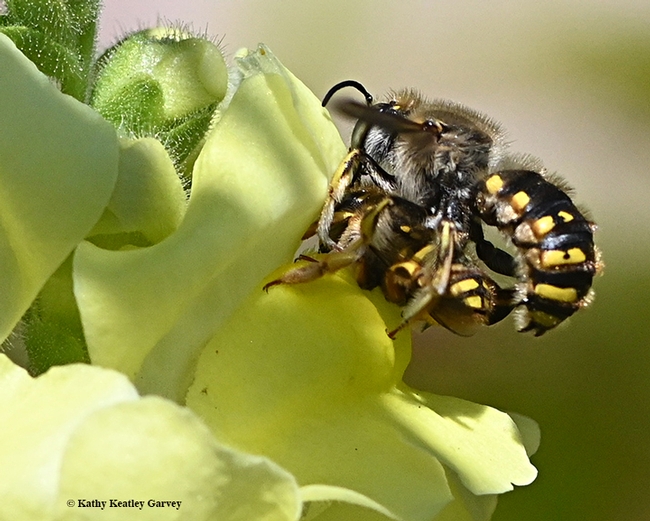
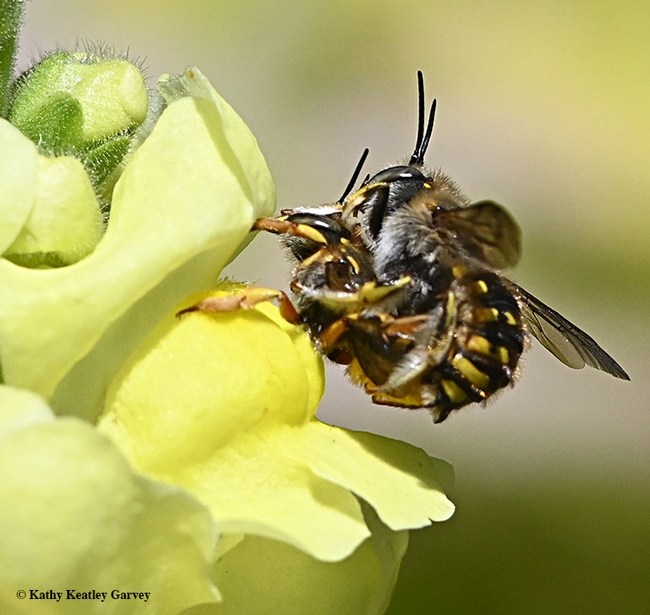
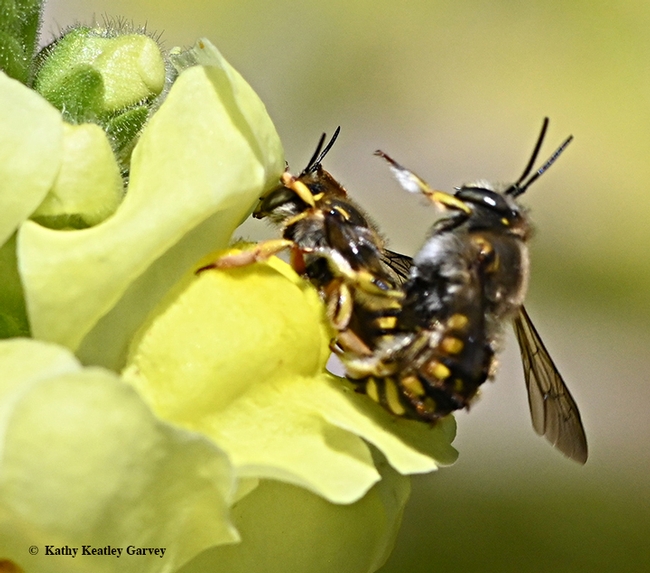
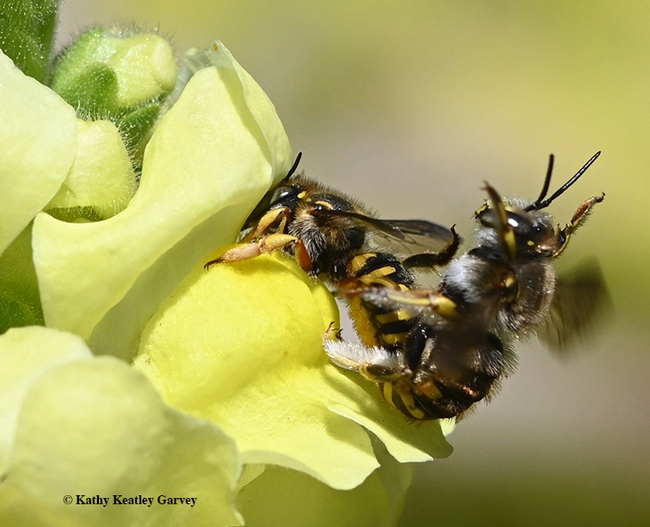
- Author: Kathy Keatley Garvey
What a show!
Last weekend we spotted female European wool carder bees (so named because they collect or card plant hairs for their nests) buzzing in and out of our snapdragons.
The bees, about the size of honey bees, are mostly black and yellow. The females range in body length from 11 to 13 millimeters, while the males are 14 to 17 mm.
The males are very territorial. As we mentioned in a previous Bug Squad blog, they put the "terror" in territorial. The males bodyslam other insects, as they try to protect their turf, per chance to mate with the females. We've seen the males terrorize the much larger Valley carpenter bees--bodyslamming them, dislodging them and chasing them away.
The European wool carder bees, Anthidium manicatum, are natives of Europe. Their "immigrant ancestor" was first detected in the United States (New York) in 1963, and the species spread west. It was first recorded in California (Sunnyvale) in 2007.
The bee, according to research entomologist Tom Zavortink of the Bohart Museum of Entomology at UC Davis, was accidentally introduced into New York state. It was not purposefully introduced to pollinate alfalfa, as some reports allege, he said.
Writing in a 2008 edition of the Pan-Pacific Entomologist, Zavortink and fellow entomologist Sandra Shanks, now of Port Townsend, Wash., pointed out that several papers “have documented its spread from neighboring areas in the northeastern United States and southern Canada” and that the species has since crossed the country. It was confirmed in Colorado in 2005, Missouri in 2006, and Maine, Michigan, Maryland and California (Sunnyvale) in 2007, the entomologists wrote. Records show it was first collected in Davis on July 26, 2007.
It was well established in the Central Valley by 2008, according to Lynn Kimsey, director of the Bohart Museum of Entomology and UC Davis professor of entomology.
In Vacaville, we first encountered the European wool carder bee in the spring of 2010.
Its plant preferences include lamb's ear (Stachys byzantine, in the mint family Lamiaceae), a perennial grown for its fuzzy, silvery gray-green foliage. It's also been collected in the figwort/snapdragon family (Scrophulariacae) and the pea and bean family (Fabaceae), according to the Zavortink-Shanks research.
Usually the European wool carder bees are hanging around our foxgloves and catmint (neither is blooming yet) and our lavender (blooming but being ignored).
But snapdragons? We've never seen them foraging on snapdragons (Antirrhinum) until now. That's because we've never planted snapdragons until this spring!
